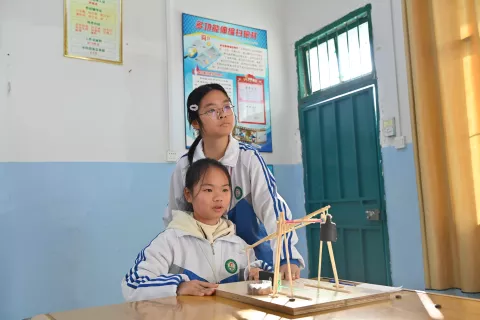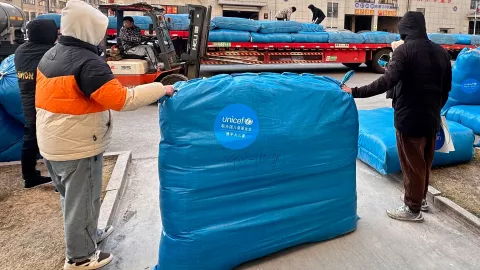One year after China earthquake, schools bring hope and opportunity
One year after China earthquake, schools bring hope and opportunity
- Available in:
- 中文
- English
XIHE, China, 11 May 2009 – Well before dawn, sixth-grader Yang Mei, along with her younger brother Yang Zhen and sister Yang Yamei, leave their home in rural Gansu province for school.
Mei still feels the impact of the devastating earthquake that struck China a year ago tomorrow. The roof of her home collapsed, and her school was seriously damaged. While the school didn't collapse, its buildings were deemed unsafe for studies.
Temporary classrooms
"We were in the classroom when the earthquake happened," said Mei. "It suddenly felt like the classroom was moving. We all went outside."
Mei and the other 250 students at Caoyang Primary School now study in temporary, pre-fabricated classroom buildings installed by UNICEF. They have also received new school bags and hygiene kits, as well as sports equipment for class breaks.
With the installation of new toilets and washrooms, the temporary school will soon enjoy proper sanitation as well.
Poorest areas affected
Though Gansu didn't suffer the widespread devastation that the earthquake inflicted on Sichuan province, it saw more than 6,000 school buildings damaged beyond use – and the province has few resources of its own to deal with the problem. In Xihe county, one of the poorest in China, all 334 schools were affected by the disaster.
The earthquake also damaged water supply systems, so that villagers – including children – had to fetch water from unprotected valley streams or collect rainwater from rooftops or plastic sheets.
Over the past year, UNICEF has provided about $20 million in assistance to earthquake areas in Sichuan, Gansu, Shaanxi and other affected provinces. That aid has been delivered, in cooperation with national and local government agencies, in 29 counties and districts across three provinces covering a population of 2.5 million children and 4 million women.
Child-friendly schooling
During the emergency phrase, in the immediate aftermath of the quake, UNICEF rushed medical supplies, ambulances, tents, educational materials, mobile toilets, water-purification units and tablets, and other supplies to the affected areas.
In the reconstruction period, UNICEF has been working with communities to provide safe water to children and their families, ensure quality education for students, help children recover from the psychological impact of the disaster, rehabilitate health-care services and provide micronutrient supplements for children and pregnant women.
In Gansu province, UNICEF is also training hundreds of teachers to introduce a child-friendly school (CFS) approach. The CFS model, which is currently being rolled out globally by UNICEF, addresses the needs of the whole child and provides practitioners with information and tools to create and strengthen child-friendly learning environments for all children in all circumstances.
CFS programmes stress the importance of child-centred classroom practices and school environments that are safe and protective of children – including safe construction. They also encourage democratic participation and gender equality.
'We want her to study'
For young people like Mei, education makes a vital difference. She suffers from congenital heart disease and underwent expensive heart surgery last year. Her family is determined to help her stay in school so that she can have the same opportunity as her brother to choose her own future.
"Aren't they all the same?" laughed Mei's father, Yang Jianguo. "Mei, she is really clever and her body is not in good health, so we want her to study."
A year after the earthquake, aid for schools is helping girls and boys in rural China finish their studies, regardless of disaster or disability.




